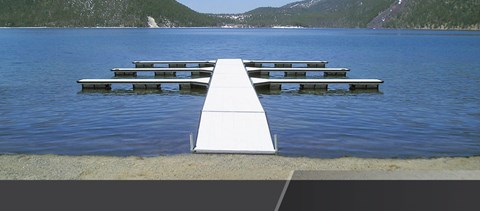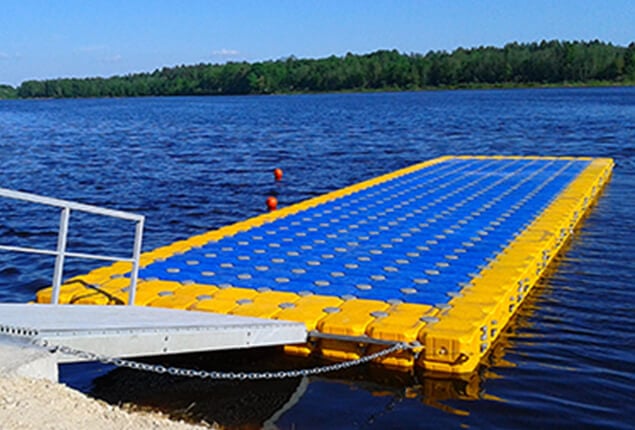Crafting Custom Solutions: Why a Floating Dock Builder is Important for Distinct Requirements
Produce the Perfect Docking Remedy With Floating Docks
Floating docks present a versatile service for a variety of maritime demands, adjusting perfectly to fluctuating water degrees and diverse vessel kinds. As we explore the essential aspects that contribute to the performance of floating docks, several crucial elements concerning security and maintenance will arise, elevating concerns about just how to enhance your docking experience.

Advantages of Floating Docks
Floating docks deal countless benefits that make them a suitable option for different maritime applications. Unlike repaired docks, floating docks surge and loss with the trend, guaranteeing consistent access for vessels.
In addition, floating docks are commonly much easier and quicker to set up compared to traditional set frameworks. Their modular style allows for straightforward setting up and disassembly, facilitating maintenance and moving when required. This adaptability is particularly useful for momentary applications or in environments where problems may change.
Floating docks additionally have a tendency to be more eco-friendly, as they lessen disruption to the seabed and bordering water ecological communities. Their resilient nature minimizes the risk of damages to marine life, advertising a healthier setting. In addition, these docks can be tailored to fit various vessel dimensions, guaranteeing that they fulfill certain operational requirements - dock company.
Eventually, the mix of versatility, simplicity of installment, and environmental factors to consider makes floating docks an extremely reliable solution for a broad array of maritime requirements.
Selecting the Right Materials
Picking the suitable products for floating docks is important to ensure long life, durability, and stability. The option of products straight influences the dock's efficiency in different ecological problems, consisting of direct exposure to water, sunshine, and possible wear from aquatic website traffic.
Usual products made use of for floating docks consist of light weight aluminum, timber, and high-density polyethylene (HDPE) Light weight aluminum is light-weight, corrosion-resistant, and calls for marginal upkeep, making it an excellent selection for durability. Its initial cost can be higher contrasted to various other products.
Wood, while cosmetically enticing and supplying a typical appearance, can be prone to rot and bug damage otherwise properly dealt with. Using pressure-treated timber or normally durable types like cedar or redwood can alleviate these concerns.
HDPE is a prominent option because of its resistance to UV rays and chemicals, in addition to being ecologically friendly. floating docks. It is light-weight and offered in various shades, permitting personalization
Ultimately, the right product selection will certainly depend on particular requirements, consisting of budget plan, wanted appearances, and ecological factors to consider. Cautious evaluation of these aspects will cause a successful and resilient floating dock remedy.
Design Considerations for Security
When creating floating docks, making certain stability is a fundamental element that can dramatically affect their functionality and security. Stability in floating dock style is affected by numerous factors, including buoyancy, weight distribution, and the plan of elements.
Weight circulation is important; equally dispersing lots across the dock stops tilting and boosts security. Larger designs can supply raised stability, especially in harsh water conditions, while longer docks might call for extra assistances to stop drooping.
One more essential consideration is the environmental impact, including wave activity and wind. Incorporating attributes such as sidewalls or skirting can assist reduce the effects of ecological pressures, preserving stability in adverse problems. Ultimately, a mix of thoughtful this hyperlink style, material choice, and understanding of environmental variables will generate a floating dock that fulfills both stability and security requirements.
Setup Tips and Techniques

Next, secure the needed licenses and abide by regional guidelines, which might determine installment approaches and ecological considerations. Engage a certified contractor experienced in floating dock installations if needed. Use high-quality materials developed for aquatic environments to improve durability and longevity.
When positioning the dock, align it parallel to the coastline to assist in simple gain access to. Guarantee that the anchoring system find more is durable, utilizing concrete blocks or helical supports to support the dock against wind and wave activity. It's crucial to make up seasonal water degree fluctuations, consisting of prospective ice movement in chillier environments.
Throughout the setup, verify the dock's floatation and stability before completing the anchoring. Routinely evaluate the installation for any indicators of wear or damage. By adhering to these pointers and strategies, you can achieve a safe and secure, practical, and visually pleasing floating dock setup that satisfies your requirements.
Upkeep and Care Guidelines
Keeping and caring for floating docks is important to lengthening their life expectancy and making certain safe use. Regular evaluations need to be carried out to recognize any type of indicators of wear, damage, or aquatic development. Search for cracks, loosened fittings, or tarnished locations on the dock's surface, as these problems can compromise architectural integrity.
Cleaning up is necessary. Use a pressure washer to eliminate algae, barnacles, and particles, which can gather over time. For stubborn growth, take into consideration environmentally pleasant cleansing representatives that won't harm water life.
In addition, examine the mooring lines and anchors useful content often to guarantee they are secure and complimentary from corrosion. Change any type of frayed or damaged lines quickly to preserve security.
During extreme weather condition, such as storms or freezing problems, take precautionary actions. Safeguard the dock with extra mooring lines and, if practical, eliminate any detachable parts to avoid damages.
Final Thought
In conclusion, the application of floating docks provides a reliable and versatile docking option ideal for different maritime applications. With proper setup and normal maintenance, floating docks can provide efficient and reliable docking experiences for a vast range of vessels.
As we explore the vital aspects that add to the effectiveness of floating docks, numerous vital factors relating to stability and maintenance will certainly arise, raising concerns regarding just how to maximize your docking experience. Unlike repaired docks, floating docks rise and autumn with the trend, ensuring constant accessibility for vessels.When making floating docks, guaranteeing security is an essential aspect that can significantly influence their functionality and safety. Security in floating dock style is affected by different aspects, consisting of buoyancy, weight circulation, and the arrangement of components. Ultimately, a combination of thoughtful design, material selection, and understanding of ecological factors will certainly generate a drifting dock that fulfills both security and security demands.